Are you a fanatic about footwear? Do you want to know how to start your own shoe line and make over $60k a month? Afshan Abbas, founder of Fuchsia Shoes, did it!
Before Afshan started her business, she quit her job as a software engineer at Microsoft to follow her passion for artisan arts and crafts (including shoes).
Over the past 4 years, she’s worked to grow her business from $100k in revenue to being on track to make $1 million this year.
In this article, we’ll tell you how to start a shoe line step-by-step. Follow our guide and Afshan’s advice to realize your passion and build your own shoe empire.
1. Get Fashion Design Training and Experience
If you’re thinking of starting a shoe line, you probably already have an interest or some experience in fashion design. However, shoe design isn’t a business to take lightly.
It’s necessary to know what you’re doing (or at least partner with someone who does!).
The best way to get training in the retail shoe industry is to attend a school that features a program in fashion design or retail.
Even better, you can find schools devoted to fashion design with a department that focuses on shoe design and development. Here are a few to consider:
- Fashion Institute of Design and Marketing
- Fashion Institute of Technology
- Pensole Footwear Design Academy
You also should consider classes or a certification course in business and/or entrepreneurship. This will help you tremendously with the non-design aspects of your shoe line.
Work in the Retail Industry
Though helpful, degrees and certifications are not a requirement to start your shoe line. They’re also not an indicator of your chances of success. However, it’s best to have experience in the retail industry.
Work in areas where you can gain an understanding of fashion buying and the things that drive consumers to purchase particular products (e.g. Why do people buy this shoe brand over another brand?).
This experience can also help you network with others who may become key allies in your quest to start your own shoe empire.
2. How Do I Start My Own Shoe Line? Start Researching!
We spoke with Afshan to get her insights and tips on how to start a shoe company and create a profitable e-commerce business. You can watch part 1 and part 2 of our interview with Afshan to hear her story.
Afshan explained that she did quite a lot of research before launching her shoe line.
Analysts project the global footwear market to reach a value of over $500 billion by 2027. And if you want a slice of that pie, you must narrow down your market and make key choices that will guide the course of your business.
The easiest (and fastest) way to open a shoe store is to buy one that’s already up and running. You can check business listings to see what’s available in your area and how much you should expect to spend.
Questions to Consider When Researching

We’ll help you answer some of these in the next sections, but here are some questions to research and consider before you proceed:
- What is the market analysis of the entire shoe industry?
- Are you making active, non-active, or both types of footwear?
- What is your niche in the shoe business? (See Step 3)
- Do you want to be gender-specific?
- Who is your competition?
- Are you designing your line or do you need to find a designer?
- What are the costs of your supplies and where will you get them?
- Do you intend to mass-produce your line?
3. Determine Your Niche and Sales Platform
To solidify Afshan’s statement, here is a list of the 20 “best” running shoe brands. You can find a similar list for most styles of shoes.
To gain a foothold (get it?) in the market, you must determine how your shoe line will stand out above the competition. For Fushsia Shoes, Afshan and her team ran with (I can’t stop!) a luxury ballet shoe niche.
Some other niche examples to research for inspiration include:
- Keen – Known for their Uneek shoe made from recycled plastic and shoes that accommodate work and outdoor activities (steel toe, waterproof, slip-resistant).
- Nobull – Marketed to the CrossFit crowd. Nobull makes stripped-down training shoes for athletes.
- Simon Miller Shoes – Luxury thick-soled shoes and boots along with designer platform and heel shoes. They also have a vegan leather collection.
- By Far – Designer shoes that are a throwback to the ’80s ’90s and early 2000s.
Here are some questions you can ask yourself when trying to determine your niche:
- Can my shoe line solve a problem?
- Will it market to a specific audience?
- Will my design offer a distinct improvement over other brands?
- Is there something that makes my line special?
- Is there a section of the market that is underserved?
Ecommerce is the Way
We won’t tell you how to run your business. But if you haven’t noticed, brick-and-mortar retail spaces are being slaughtered by ecommerce (pandemic aside).
Unless you own an existing space or have access to free rent, determining the sales platform of your shoe line is an easy decision.
Here’s what Afshan had to say on the subject:
If you’re not experienced with ecommerce or need to polish your skills, edX, Udemy, and Coursera offer excellent courses on the subject.
4. Write a Business Plan

Every company needs a business plan. It’s an essential document that summarizes the research and decisions you made about the course of your business.
It acts as a guide that lays out your ideas and serves as a quintessential document for loan applications or investor recruitment.
What’s in a Business Plan?
- Market Analysis
- Mission Statement
- Startup and Operating Costs
- Marketing Plan (Target Market)
- Supply and Manufacturing Chain
- Sales Funnels
Templates
- Startup business plan template
- U.S. Small Business Administration Business Plan Guide
- 500 sample business plans
- One page business plan template
How Much Money Do You Need to Start a Shoe Line?
In order to complete your business plan, you must determine the startup and operating costs for your business. Doing so requires you to assess and decide the scale of your operation.
Afshan’s business started as a global venture with domestic and international customers.
Her operation, though small when compared to a brand like Nike, was actually large in scale for a startup shoe line. We asked her about Fuchsia’s startup costs, and she said:
To put things into perspective, here are the average startup costs for a small, medium, and large-scale shoe line.
- Small – $30,000
- Medium – $110,000
- Large – $200,000 and up
Remember, you can always start small and scale up as you increase your revenue and streamline your operation.
5. Create Your Brand
Once you determine your market and niche, it’s time to create your brand. Your brand differs from your product because it is the means by which people identify your product.
For example, when you see a “Swoosh” on a pair of shoes, you know they were made by Nike.
What Makes Up a Brand?

There are many elements to consider when creating your brand, but here’s a short list:
- Logo
- Colors
- Font and Typography
- Web Design
- Story
Branding Resources
Remember that your brand should be distinct, memorable, scalable, and easy to apply. It’s not a simple task, but neither is designing and manufacturing a shoe, as you’ll see in the next steps.
To help you, here are 101 brand-building tools and a great branding resource from the experts at HubSpot.
6. Choose a Business Name
Business names are more important in some industries. The name of your shoe line is the direct connection to your brand.
When choosing a name, consider what you want people to think when they hear it, and think about the following tips.
If you need help to get started, try an A.I.-powered naming service like Namelix or BNG to point you in the right direction.
Avoid a Name That is Hard to Spell
Since you’ll likely engage in an ecommerce business, choose a name that’s easy to spell and find on a web search. Don’t risk losing potential customers because they can’t remember how to spell it correctly.
Don’t Pick a Name that Limits Your Growth
Think big when choosing! You don’t want to limit your growth just because your business name is too narrow.
For example, what if “Nike” had named themselves “Nike Shoe Retailers of Oregon?” It would have limited their potential to grow into an international brand that also markets other apparel.
Secure the .com Domain
Before picking your name, do a thorough internet search and check the availability of the domain name and related spellings. If someone else has already established the name, it may be wise to reconsider.
You can check the domain here and register it with Google, GoDaddy, or Namecheap.
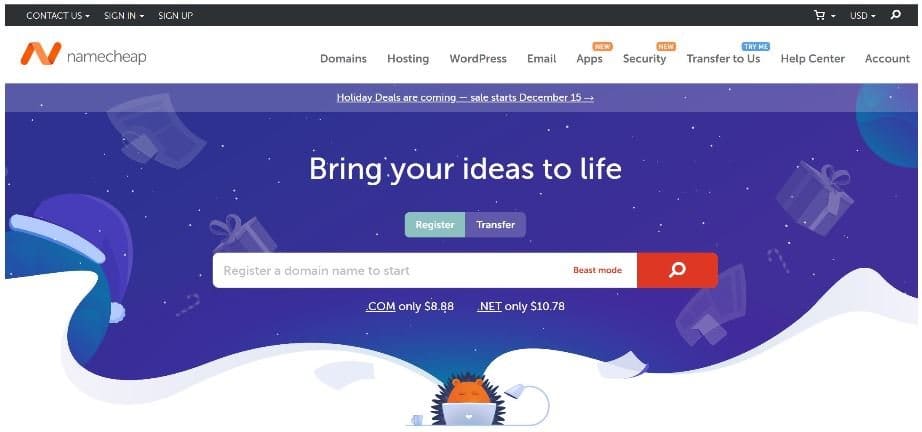
Test it Out
Afshan and her team chose Fuchsia Shoes, and the title of her webpage is “Fuchsia Shoes: Luxury Ballet Flats.”
This works wonderfully with her brand considering people recognize fuchsia as a beautiful color and associate it with a flower that is equal in that respect.
Once you choose your name, talk to others about it to see if it represents your ideal branding.
If you need some help, you can read this article with 12 tips on how to name your business, and be sure to register your name at the federal and state levels.
7. Register Legal Entity
Once you’ve chosen a name, it’s time to register your business for taxes and establish a legal structure.
Before choosing a business structure, do your research and work with an accountant or business attorney to maximize your legal and tax benefits.
Licenses and Permits
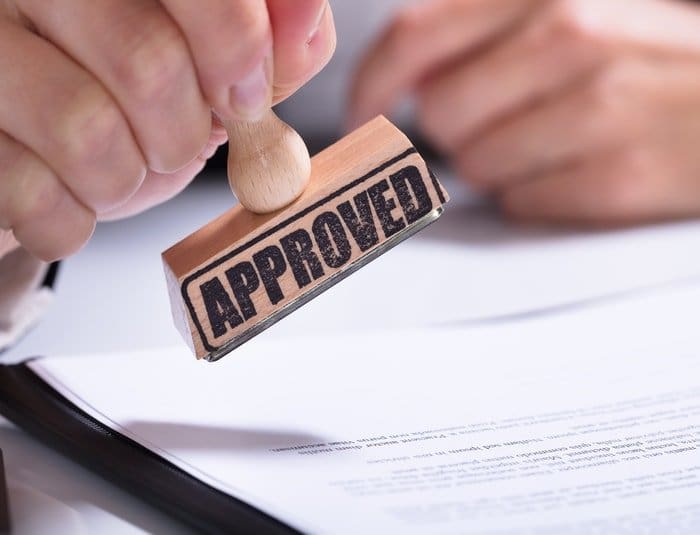
Aside from your legal structure, you must also determine whether your business requires specific licenses or permits to operate. No worries! The SBA has a tool you can use to check.
Legal Structures
There isn’t a standard legal structure to start a shoe line. You have five base options to review with your accountant or attorney: Sole Proprietorship, Partnership, Corporation, S Corporation, or Limited Liability Corporation.
The IRS has a great resource to help you better understand these structures.
Limited Liability Corporation (LLC)
Though there’s no standard for a shoe business, you’ll most likely register your business as an LLC. This will allow you to protect and separate your personal assets from your business.
Also, you can pass on profits and losses from your business as personal income without corporate taxes.
However, we cannot stress enough to find a qualified attorney or accountant before choosing your legal structure.
8. Funding Your Shoe Line

Think of funding as a two-step process. First, there is funding to build your team and create initial designs, sketches, and prototypes. Then, you’ll require more funding for manufacturing and larger-scale production and distribution.
How Do I Raise the Money?
As we explained earlier, there are three scale tiers of startup costs to start your own shoe line (small, medium, and large). Your funds to launch can come from a variety of sources:
- Personal funds
- Personal loan from family or friends
- Business investors (Afshan’s path to launch)
The SBA also has loan programs and other funding programs to help small businesses launch.
Another option, if you have good credit, is to use a credit card with an interest-free period to help launch things. Ideally, you’ll make enough money to pay off the card before the interest kicks in.
You can also try crowdfunding, a home equity loan, or a rollover for business funding from your retirement plan (ROBS).
However you obtain your funding, be sure to understand the risks before taking on any debt. If you want to educate yourself further, the SBA has a great course on business financing.
Innovating the Way Entrepreneurs Grow®
- Approvals in 24 hrs
- Work with an Expert Financing Advisor
- Access to 75+ Lenders
- Simple & Easy
- Human Intelligence over Artificial Intelligence
The Smart Way to Fund Your Business
- Find your best loan offer from competing lenders*
- Loans up to $5M. Rates from 6.00%**
- Checking rates won’t affect your credit score
9. Build Your Team: Sketches & Shoe Designs
If you haven’t already, the next step is to bring your ideas into reality by sketching and designing your shoe line.
You may think, “How can I create my own shoe line if I’m not talented at shoe design?” Don’t worry! It’s not a deal-breaker—you just need to build a team that can help.
When Afshan started her business, she was working for Microsoft as a software engineer.
She took her affinity for local artisan arts and crafts and worked with them directly to create her shoe line. You can also hire local artisans to sketch and design your shoes.
NOVICA and the Unicef Marketplace are good spots to find artisan designers. Look at their products on those sites and reach out to them directly.
However, if you’re short on local talent, there are other options.
Freelance Designers and Software Shoe Designs
There are several freelancing sites on the web with a pool of shoe designers who can help you turn your ideas into reality.
Upwork and Fiverr are two trustworthy sites where you can explain your ideas and negotiate rights and pricing before hire.

If you want to design your own shoes, there are software programs to assist. Shoemaster and Romans CAD are two design options that allow you to create 2D or 3D models you can use for prototyping.
10. Create Prototypes and Analyze Materials
As Afshan explained, the prototype stage is key to developing your shoe line. You must review your designs and take into account all of the materials that go into creating the shoe.
They must be financially viable for manufacturing, and you may need to alter your design for the shoe to be wearable.
The Mockup Shoe
The first version of the prototype may be a non-wearable “mockup” shoe made with low-quality materials. Create this shoe to get a full visual of the patterns and designs. It helps determine if the shoe is feasible for manufacture.
The Final Sample
Your final sample is a base production shoe and is the launch point for any shoe line.
This is the shoe to bring to manufacturers for evaluation and into pitch meetings for potential investors. You’ll also use your prototypes as the base for your marketing campaigns.
11. Patents and Trademarks
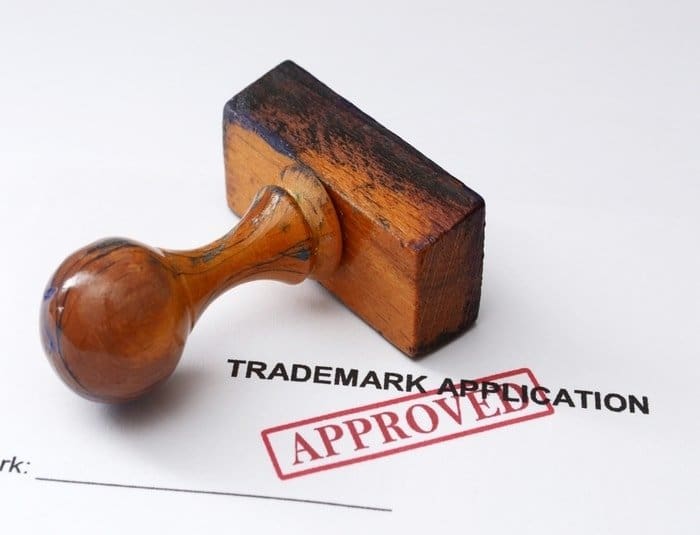
In the shoe line business, it’s important to protect your designs and brand by filing for patents and copyrights with the United States Patent and Trademark Office.
This way, if someone steals your designs or logos and tries to profit from them, you’re legally entitled to payment or royalties.
For filing, you can find an experienced patent and trademark attorney, or the U.S. PTO has all of the information you need for patent and trademark registration on their site.
They also have a search function so you can see if you’re not infringing on someone else’s design before you begin.
Keep Track of Everything
An important note before filing or working with an attorney: During your shoe line development, keep a record of your designs and ideas.
You can use a platform like Evernote (it syncs with multiple devices) or XMind (for professional prototyping) to keep things organized and well-documented.
It’s important to keep your notes as a record of a claim on a patent. When you develop your prototype, photograph it extensively and store the files securely.
12. Manufacturing: How Do You Get a Shoe Made?
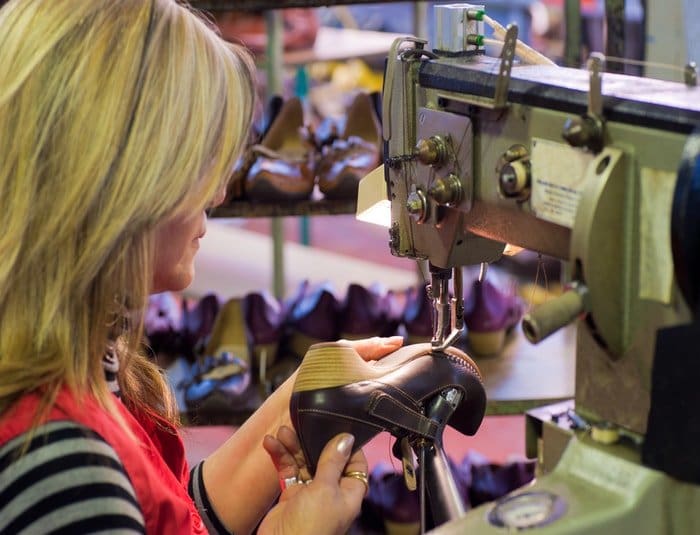
With your designs, prototypes, patents, and trademarks in place, it’s time to secure the manufacturing arm of your shoe line.
In our connected world, there are a lot of options. But first, here are some questions to answer before you go to production:
What is the Location of the Manufacturer?
Where you manufacture is a key part of your brand identity. Ever notice how some companies stamp “Made in the USA” in large print on the side of their box?
Be mindful of your choice if you intend to integrate your manufacturing process into your brand.
Also, if you intend to import your shoes from another country, you could face import taxes based on the country of origin. However, sometimes it’s cheaper to import the item and pay the fee than to have it manufactured in the U.S.
Either way, it’s a calculation you must consider when choosing a manufacturer.
Does the Manufacturer Have Minimum Order Requirements?
Most manufacturers require a minimum quantity with each order, and it can cut deeply into your budget if you’re not prepared to make a quick turn on revenue.
Review the requirements from any manufacturer before signing an agreement.
Can Your Manufacturer Handle Growth?
Like Afshan, you’ll want to start small and should research standard shoe sizes customers typically order.
Ideally, your business will grow, so you want to be sure that your manufacturing arm can handle growth. This is always a work-in-process, but it isn’t fun or profitable to pause due to supply issues.
What’s the Price Point of My Shoe Line?
Pricing is deeply rooted in the amount of funding you have and your brand.
Lower-end brands sell shoes for as low as $20 – $30 per pair because brands work to keep their materials and manufacturing price point low.
However, luxury brands sell at prices starting at $250 and can increase to over $1,000 based on perceived value.
Before choosing a manufacturer, you must review your branding and price point. Then you can match up with a manufacturer who can deliver in your range.
Tech Pack Submission and Manufacturing Resources
With those questions answered, you must create and submit a tech pack. It’s a package that contains all the designs, specifications, and components necessary to turn your prototype into a finished product.
Think of it as a blueprint for your shoe design.
There are thousands of manufacturers in the world to develop your shoe line, but here are a few standouts:
13. Packaging and Distribution
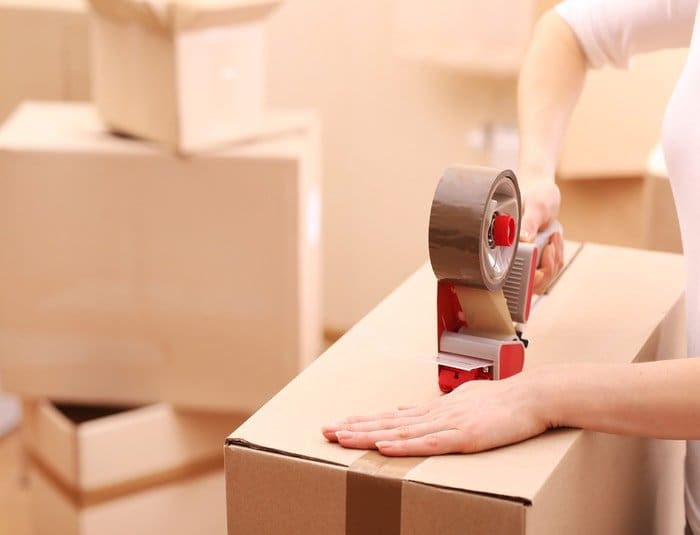
A shoebox says a lot about a brand, and it’s one of the top marketing opportunities in the shoe business.
Top shoe lines deliver shoes in a box that prominently features their label as many people keep and reuse shoeboxes for years. To keep with this industry trend, here is a list of custom shoebox manufacturers:
- The Premium Boxes
- The Custom Printed Boxes
- The Printing Daddy
- Fantastapack
Walking Your Shoes from Point A to Point B
The last element of the fulfillment process is shipping the product safely from your site to the customer.
It’s important to work with various shipping agencies (UPS, FedEx, DNS, USPS) to find the lowest prices to ship your goods. Otherwise, it can cut into your profits.
14. Establish a Marketing and Sales Plan
With your supply chain in place, the last step before opening your shoe line is establishing your marketing and sales plan.
Your marketing strategy is what your business will thrive on. Base it on the extensive market research put into your business plan. Forbes has an excellent resource on developing a marketing strategy.
A sales strategy defines your approach to selling your product. Both plans are essential to revenue generation and should be two of your biggest investments.
If you don’t have experience, consider hiring a marketing and sales consultant through a freelancing site like Upwork.
Digital Marketing & Social Media
Digital marketing means engaging potential customers on digital platforms through email campaigns, newsletters, digital advertising, search engine optimization (SEO), and social media.
The key to digital marketing is that it nets a higher ROI (return on investment) than traditional marketing methods.
Social Media

Your social media presence is essential to your brand and is a great way to engage with your customers.
It’s also the primary method you can use to obtain analytics and figure out better ways to market your product. Interact with your customers via posts and encourage them to post pictures about your shoe line!
Afshan used social media to develop marketing relationships with influencers who are also sustainability advocates.
Through those relationships, she was able to increase her brand’s reach, directly access her target market, and turn her customers into marketers.
Website
If you’re starting an ecommerce-based business like Afshan, then your website is your storefront. That means you need to invest heavily in designing and optimizing your site.
If you’re not good at web design or don’t have experience, there are a lot of resources to help you find a reliable web designer and webmaster to run your site.
However, as an ecommerce business, work with a designer and webmaster with experience setting up and maintaining an ecommerce shopping cart.

Refine Both Strategies and Watch Your Revenue Grow
Fuchsia’s revenue jumped from $150k in 2019, but they’re already at $400k in 2020 and on track to do $1 million by the end of the year.
We asked Afshan what contributed to the large jump in revenue and she said,
Conclusion
With these steps, you now know the essentials and have resources on how to start a shoe line.
As we said, analysts expect the shoe industry to grow over the next decade. So get started now to make your presence known and take your place.
To send you off, here’s one final piece of advice from Afshan on how to be successful in the industry:
Do you have any experience in the shoe or fashion industry? Let us know what you think!




